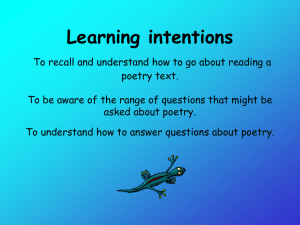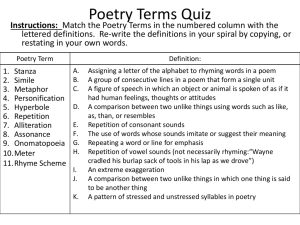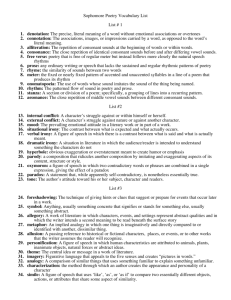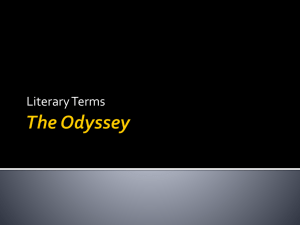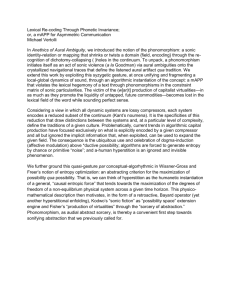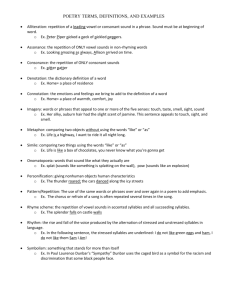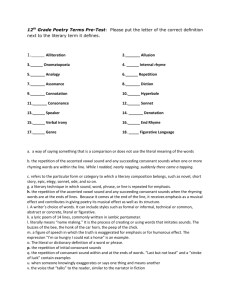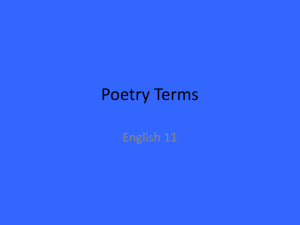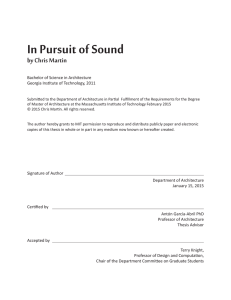Literature Terms #4: Sonic and Rhythmic Devices, Structure
advertisement
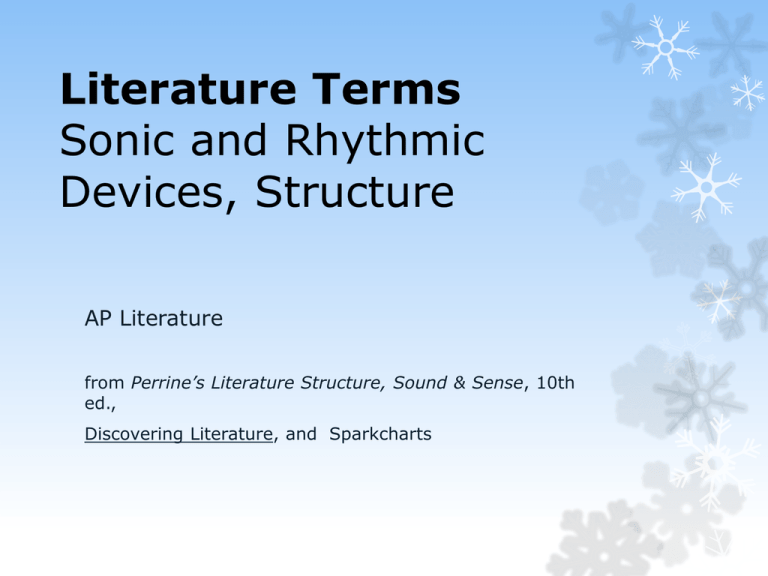
Literature Terms Sonic and Rhythmic Devices, Structure AP Literature from Perrine’s Literature Structure, Sound & Sense, 10th ed., Discovering Literature, and Sparkcharts What is poetry? Poetry is a literary form characterized by a strong sense of rhythm and meter and an emphasis on the interaction between sound and sense. The study of the elements of poetry is called prosody. “Poetry is as universal as language and almost as ancient. The most primitive peoples have used it, and the most civilized have cultivated it.” What makes poetry so appealing? Simple enjoyment It is regarded as giving value to the fully realized life— something central to existence. Something that, without which, we are spiritually impoverished What is poetry? “Poetry might be defined as a kind of language that says more and says it more intensely than does ordinary language.” It “exists to communicate significant experience— significant because it is concentrated and organized.” What is poetry? “Poetry makes a greater use of the “music” of language than does language that is not poetry. The poet, unlike the person who uses language to convey only information, chooses words for sound as well as for meaning, and uses the sound as a means of reinforcing meaning.” Literary Term: Sonic Devices “Poets may repeat any unit of sound from the smallest to the largest. They may repeat individual vowel and consonant sounds, whole syllables, words, phrases, lines or groups of lines.” (alliteration, assonance, consonance, rhyme) Sonic Devices The repetition of sound serves several purposes: 1. It is pleasing to the ear 2. It emphasizes the words in which the repetition occurs 3. It gives structure to the poem Sonic Devices Alliteration: Repetition at close intervals of the initial consonant sounds of accented syllables or important words: “descending dew drops” “luscious lemons” “Inebriate of Air-am I” Sonic Devices Alliteration: Is based on the sounds of letters, rather than the spelling of words: “keen” and “car” alliterate; but “car” and “cite” do not Used sparingly, it can intensify ideas by emphasizing key words. Sonic Devices The Eagle He clasps the crag with crooked hands; Close to the sun in lonely lands, Ringed with the azure world, he stands. The wrinkled sea beneath him crawls; He watches from his mountain walls, And like a thunderbolt he falls. -Alfred, Lord Tennyson Sonic Devices Suicide’s Note The calm, Cool face of the river Asked me for a kiss. -Langston Hughes Sonic Devices Assonance: The repetition of similar vowel sounds in a sequence of nearby words that do not end the same “hat…ran…amber” “asleep under a tree” “mad as a hatter” “each evening” “time out of mind” “free and easy” “slapdash” Sonic Devices Consonance Repetition of consonant sound in any position A common type of near rhyme that consists of identical consonant sounds preceded by different vowel sounds “home…same” “worth…breath” Sonic Devices In Shakespeare’s Macbeth: “Life’s but a walking shadow, a poor player, That struts and frets his hour upon the stage And then is heard no more. It is a tale Told by an idiot, full of sound and fury, Signifying nothing.” Sonic Devices Euphony: “good sound” Refers to language that is smooth and musically pleasant to the ear “Many consider “cellar door” one of the most euphonious phrases in English.” Sonic Devices Cacophony: harsh sounds The clash of discordant sounds within a sentence or phrase. A familiar feature of tongue twisters but can also be used to poetic effect. It is language that is discordant and difficult to pronounce. Sonic Devices Cacophony: “Player Piano” “never my numb plunker fumbles.” -John Updike Sonic Devices Onomatopoeia The use of a word that resembles the sound it denotes. Words like buzz, rattle, bang, and sizzle all reflect onomatopoeia
